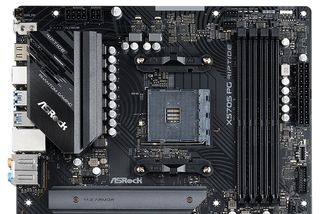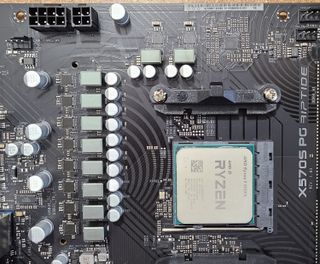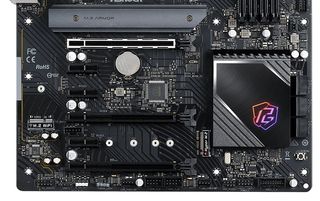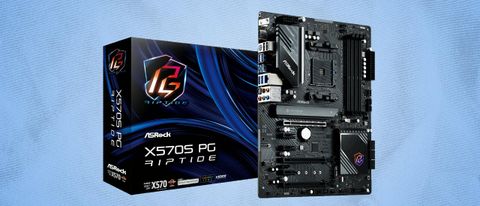Tom's Hardware Verdict
The ASRock X570S Riptide’s appearance may not win you over, but the fanless chipset cooler, sub-$200 price point and overall feature set make this a solid build option in the budget space.
Pros
- +
+ $185 price
- +
+ Fanless chipset cooler
- +
+ Killer 2.5 GbE
Cons
- -
No USB 3.2 20 Gbps ports
- -
Mediocre ALC897 audio codec
- -
Basic styling may not be for everyone
Why you can trust Tom's Hardware
The recent release of the X570S chipset update (nixing the need for a chipset fan) allowed motherboard partners to update their product stacks and get something new out for AMD builders before the arrival of Zen 4 sometime next year. We’ve seen some announcements along these lines in recent weeks, including one from Gigabyte focusing on high-end X570s models. But ASRock was the first company to get an X570S board to us for testing. And interestingly, the ASRock X570S Riptide leans more toward the affordable end of the spectrum, with a $185 MSRP.
As far as features go, the most significant difference with the X570S Riptide compared to ASRock’s X570 lineup is the lack of a chipset fan. The Riptide looks like a budget board, with most of the PCB exposed, outside of the chipset and M.2 heatsink, but it’s far from unattractive. Outside of that, the Riptide includes two PCIe 4.0 M.2 sockets, Killer-based 2.5 GbE, six SATA ports, and VRMs capable of supporting the flagship AMD Ryzen 9 5950X processor at stock and while overclocked.
In terms of performance, the Riptide held its own among all the other, more expensive (and louder), X570 motherboards we’ve tested. The Riptide boosts our CPU to 5GHz-plus, so you’ll get exactly what you should when using this board at default settings. When overclocked, the board’s VRMs ran on the hot side, but still well within specification. Read on as we dig into the details and performance results of the X570S Riptide.
Specifications - ASRock X570S Riptide
| Socket | AM4 |
| Chipset | X570S |
| Form Factor | ATX |
| Voltage Regulator | 10 Phase (50A MOSFETs for Vcore) |
| Video Ports | HDMI (v2.1) |
| USB Ports | (1) USB 3.2 Gen 2, Type-C (10 Gbps) |
| Row 6 - Cell 0 | (3) USB 3.2 Gen 2, Type-A (10 Gbps) |
| Row 7 - Cell 0 | (4) USB 3.2 Gen 1, Type-A (5 Gbps) |
| Row 8 - Cell 0 | (2) USB 2.0 |
| Network Jacks | (1) 2.5 GbE |
| Audio Jacks | (5) Analog + SPDIF |
| Legacy Ports/Jacks | PS/2 |
| Other Ports/Jack | ✗ |
| PCIe x16 | (1) v4.0 (x16) |
| Row 14 - Cell 0 | (1) v4.0 (x4) |
| Row 15 - Cell 0 | (1) v4.0 (x2) |
| PCIe x8 | ✗ |
| PCIe x4 | ✗ |
| PCIe x1 | (3) v4.0 (x1) |
| CrossFire/SLI | AMD Quad CrossfireX and CrossFireX (2-Way) |
| DIMM slots | (4) DDR4 5000+(OC), 128GB Capacity |
| M.2 slots | (1) PCIe 4.0 x4 / PCIe Only (up to 80mm) |
| Row 22 - Cell 0 | (1) PCIe 4.0 x4 / SATA + PCIe (up to 110mm) |
| U.2 Ports | ✗ |
| SATA Ports | (6) SATA3 6 Gbps (RAID 0, 1, 5 and 10) |
| USB Headers | (1) USB v3.2 Gen 2 (Type-C) |
| Row 26 - Cell 0 | (2) USB v3.2 Gen 1 |
| Row 27 - Cell 0 | (2) USB v2.0 |
| Fan/Pump Headers | (7) 4-Pin (2A/24W each) |
| RGB Headers | (2) aRGB (3-pin) |
| Row 30 - Cell 0 | (2) RGB (4-pin) |
| Legacy Interfaces | ✗ |
| Other Interfaces | FP-Audio |
| Diagnostics Panel | Post Status Checker (4 LED, CPU/RAM/VGA/Boot) |
| Internal Button/Switch | CMOS Reset |
| SATA Controllers | ✗ |
| Ethernet Controller(s) | Killer E3100G (2.5 GbE) |
| Wi-Fi / Bluetooth | ✗ |
| USB Controllers | ✗ |
| HD Audio Codec | Realtek ALC897 |
| DDL/DTS Connect | ✗ / ✗ |
| Warranty | 3 Years |
The included accessory stack that comes in the box with the X570 Riptide is pretty thin on this budget-priced board, but should still include most of what you need to get going. A great value-add to this stack is the Graphics card holder. With the best graphics cards seemingly growing in size by generation, this unique (patent pending) device that mounts to the motherboard should prove helpful to those with oversize GPUs. Below is a complete list of the included accessories from the ASRock website.
- (2) SATA cables
- Graphics card holder
- (3) screws for M.2 sockets
- Standoff for M.2 socket
- Manual/User Guide
- IO Plate



After removing the motherboard from the packaging, we’re greeted by a semi-gloss black PCB along with grey accent lines swirling around the board--perhaps like a Riptide?. There’s a large heatsink covering the left VRM bank, with the ASRock name and Phantom Gaming branding on top. Only one of the two M.2 sockets has a heatsink, and in another effort to save money, the audio and PCIe areas aren’t covered in shrouds as most pricier boards are these days.
The only integrated RGB elements hide under the chipset heatsink and illuminate the Phantom Gaming symbol on the fanless heatsink. If you want more, there are ARGB and RGB headers for expansion. Overall, the board should look fine in most builds. That said, it likely won’t be the focal point, as some premium motherboards often are, but surely won’t take away from the aesthetic.

Starting with the top half, we get a closer look at the “XXL” heatsink for the left VRM bank and the fully exposed top of the VRM bank. Delivering power to the CPU is a required 8-pin EPS connector and an optional 4-pin connector. Although the temperatures were in order in our open-air test system, I would still like to see both VRM banks with heatsinks.
Just below is the first of several (seven to be exact) 4-pin fan headers. Several headers (CPU_FAN2/WP, CHA_FAN1/2/3/4/5/WP) auto-detect three (DC) or four-pin (PWM) configurations. The CPU fan connector supports up to 1A/12W, while the CPU/Water Pump header and the Chassis/water pump connectors support up to 2A/24W. This should be plenty of power for most fans and pumps.
To the right of the socket area are four unreinforced DRAM slots. The Riptide supports 128GB of RAM, with speeds listed up to DDR4 5000+(OC). Per usual, your mileage will vary there, as reaching those speeds requires a processor with a great integrated memory controller (IMC) and a suitable memory kit to do so. We easily ran our DDR4 3600 kit at 1:1 in both 2x8GB and 4x8GB configurations. Much beyond that and you’re veering away from the performance-to-cost ratio.
Located above the DRAM slots are two more fan headers and the first 3-pin ARGB and 4-pin RGB headers. Wedged between these two features is the Post Status Checker (PSC). PSC diagnoses the computer during the POST process and emits a red light to indicate if CPU, Memory, VGA, or storage is non-functional. The lights disappear when the parts above function normally. Since the board doesn’t come with a 2-character POST code LED, this is a valuable feature to have when troubleshooting POST issues.
On the right edge of the board is a 24-pin ATX connector to power the board/slots/sockets. Below are two USB connectors, a single USB 3.2 Gen2 (10 Gbps) Type-C front panel and the 17-pin front panel USB 3.1 Gen1 connector. Last but not least here is another fan header.

Focusing on power delivery, ASRock uses a 10-phase setup for Vcore. Power is sent through a UPI uP9505 (X+Y=6) controller then onto two uP1911R PWM extenders. These extenders operate in a 4x mode quadrupling the single sent to the MOSFETs. Vishay Sic654 50A MOSFETs make up the VRM along with 60A chokes. This configuration yields a total of 500A to the CPU. While certainly not the most robust we’ve seen, what’s here did handle our Ryzen 5950X CPU without issue at stock and while overclocked to 4.4 GHz with all CPU cores and threads. Things ran warm, but well within specification.

Moving down to the bottom half of the board, we’ll start on the left-hand side with audio. Here we see a fully exposed audio section and the Realtek ALC897 codec. Additionally, we spy four Apaq brand audio capacitors and the separation line between this section and the rest of the board. Although the Riptide is a budget board and the audio solution is acceptable for most users, I would like to see a higher-end codec used here.
Just above this is the Key-E M.2 socket for a Wi-Fi card (not included). Typically we see this attached up by the rear IO area, but not with this design. You’ll have to weave the wires up to the rear IO to where the antenna connectors are located, which looks a bit amateurish. Otherwise, it’s a simple installation if needed. You can buy the latest and greatest Intel AX210 Wi-Fi 6E card for under $40 (or others that cost even less).
Moving into the middle of the board, we find three full-length PCIe slots, three x1 slots, and two M.2 sockets. Starting with PCIe, the top slot is CPU-connected and runs up to PCIe 4.0 x16. The middle and bottom slots are connected to the chipset and run at PCIe 4.0 x4 and PCIe 4.0 x2 speeds. This configuration supports AMD Quad-GPU Crossfire and 2-Way Crossfire. Additionally, the three x1 slots get their lanes from the chipset, each running PCIe 4.0 x1 speeds. Overall, there’s a lot of slots available for any cards you may want to add.
On the M.2 front, the Riptide includes two total sockets. The top socket is connected through the CPU, offering PCIe 4.0 x4 (64 Gbps) bandwidth and fits up to 80mm modules. The lower socket, M2_2 is connected through the chipset, providing the same PCIe 4.0 x4 speeds, SATA module support, and fits the same size modules (up to 80mm). Note that if a PCIe M.2 device occupies M2_2, SATA ports 5/6 will be disabled. If you’re using a Thunderbolt AIC, SATA type M.2 is disabled. The Riptide supports RAID0 and RAID 1 modes on NVMe storage devices. I would like to see three M.2 storage options, but understand this is a budget board and at that level, most people aren’t stuffing all the slots with the more expensive PCIe/NVMe based M.2 devices.
Continuing right, we run over the chipset heatsink and the only integrated RGB LED lighting. It’s quite understated, so if you’re looking for a light show, you’ll have to add it yourself via the four ARGB and RGB headers (two each) found on the board. Along the right edge are six SATA ports, supporting RAID0, 1, 5 and 10, while just below that is a Clear CMOS button.
Across the bottom are several headers, including USB ports and RGB. Here’s the complete list, from left to right:
- Front panel audio
- 3-pin aRGB and 4-pin RGB headers
- Fan header
- (2) USB 2.0 headers
- Fan header
- Speaker
- Front Panel header
- USB 3.2 Gen1 header

Flipping around to the rear IO, one of the first things you’ll notice is that the Riptide doesn’t come with a pre-installed IO plate. This is no big deal, of course, but a lot of the motherboards in the mid-range class (above this one) have plates that ship already installed. From left to right, we see the tiny black BIOS Flashback button, framing for a Wi-Fi antenna, an HDMI 2.1 port (for use with compatible AMD APUs only), and a legacy PS/2 port. Above this are two USB 2.0 ports, followed by two USB 3.2 Gen1 ports and two USB 3.2 Gen2 ports (one Type-A, one Type-C). The following stack contains two more USB 3.1 Gen1 ports and the Killer E3100G 2.5 GbE port. Last but not least is a 5-plug plus SPDIF port.
MORE: Best Motherboards
MORE: How To Choose A Motherboard
MORE: All Motherboard Content

Joe Shields is a Freelance writer for Tom’s Hardware US. He reviews motherboards.

The Raspberry Pi RP2040 Hackbat is an open source swiss army knife pen testing tool

Intel's next-gen desktop CPUs have reportedly leaked — Arrow Lake Core Ultra 200 series have same core counts as Raptor Lake Refresh, but fewer threads

Sabrent debuts 5GB/s Rocket Nano 2242 Gen 4 SSD — a good fit for Lenovo Legion Go, laptops, and NUCs
